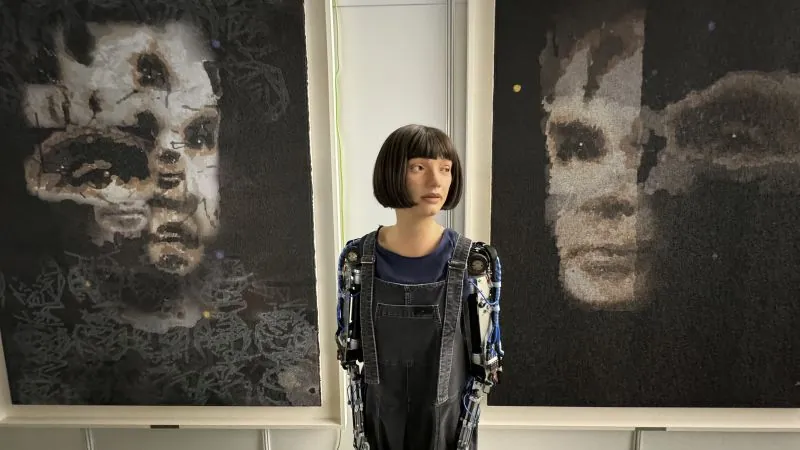
Groundbreaking AI Artwork of Alan Turing Sells for $1.08 Million – A Reflection on Humanity's Future
2024-11-08
Author: Ken Lee
Groundbreaking AI Artwork of Alan Turing Sells for $1.08 Million – A Reflection on Humanity's Future
In a stunning turn of events, an AI-generated portrait of Alan Turing, the pioneering British computer scientist and wartime codebreaker, has sold for an astonishing $1.08 million, setting a record as the most valuable artwork created by a humanoid robot ever auctioned. This sale not only broke expectations—initially estimated between $120,000 and $180,000—but also ignited significant discourse on the evolving relationship between artificial intelligence and the art world.
Titled "AI God: Portrait of Alan Turing," the artwork was created by Ai-Da, a humanoid robot characterized by its distinct black bob and robotic arms. Ai-Da engages in artistic expression using advanced large language models and was created through the collaboration of British gallerist Aidan Meller and a robotics company based in Cornwall, England.
Alan Turing, whose groundbreaking work laid the foundations for modern computing and was instrumental in decrypting German codes during World War II, tragically took his life in 1954 after being convicted under outdated homophobic laws. With the portrait, Ai-Da pays homage to Turing’s legacy eight decades after his prophetic insights into the future of AI and computing.
Meller commented that Ai-Da’s artwork is intended as a mirror reflecting contemporary societal changes and challenges, asserting, "We’re moving into a post-human world where decision-making is increasingly governed by algorithms." This artwork marks a pivotal moment in how society perceives and values AI-generated art—reminiscent of the transformative impact the invention of the camera had on the art world.
However, opinions on the significance of this sale vary widely. While supporters view it as a breakthrough for AI in art, critics like Alastair Sooke, chief art critic for The Telegraph, dismiss it as merely a flashy upgrade on the quirky tales of animals creating art.
Ai-Da commenced its artistic journey in 2019, engaging in discussions with its creators about the themes and figures it would portray. The choice of Turing arose from a conversation about “A.I. for good,” highlighting Turing's vital role in AI history. Following consultations regarding style and technique, Ai-Da methodically created fifteen distinct sketches of Turing’s features, spending six to eight hours on each, thus illustrating the vast potential of AI creativity.
To form the final piece, Ai-Da opted for three of these sketches, complemented by a depiction of Turing’s Bombe Machine, illustrating not only Turing's likeness but also his monumental contributions to computing. Due to its design limitations, Ai-Da’s painting was enlarged and printed onto a larger canvas without altering the original image to enhance its presentation for auction.
With rapidly advancing technology, Meller noted that Ai-Da is evolving in its creative agency, generating further conversations around the implications of such technologies. Ai-Da itself expressed the importance of its work as a catalyst for dialogue about the ethical challenges posed by AI's integration into society.
“AI God,” Ai-Da declared, challenges viewers to contemplate the god-like powers of AI while urging reflection on the responsibilities accompanying such advancements. With Turing’s gaze penetrating the future, this landmark sale marks yet another chapter in the ongoing dialogue surrounding the intersection of art, technology, and humanity.
As conversations about AI’s role in art continue, the auction has certainly sparked interest, raising both excitement and concern regarding what lies ahead in a world where machines could redefine creativity itself.


 Brasil (PT)
Brasil (PT)
 Canada (EN)
Canada (EN)
 Chile (ES)
Chile (ES)
 Česko (CS)
Česko (CS)
 대한민국 (KO)
대한민국 (KO)
 España (ES)
España (ES)
 France (FR)
France (FR)
 Hong Kong (EN)
Hong Kong (EN)
 Italia (IT)
Italia (IT)
 日本 (JA)
日本 (JA)
 Magyarország (HU)
Magyarország (HU)
 Norge (NO)
Norge (NO)
 Polska (PL)
Polska (PL)
 Schweiz (DE)
Schweiz (DE)
 Singapore (EN)
Singapore (EN)
 Sverige (SV)
Sverige (SV)
 Suomi (FI)
Suomi (FI)
 Türkiye (TR)
Türkiye (TR)
 الإمارات العربية المتحدة (AR)
الإمارات العربية المتحدة (AR)